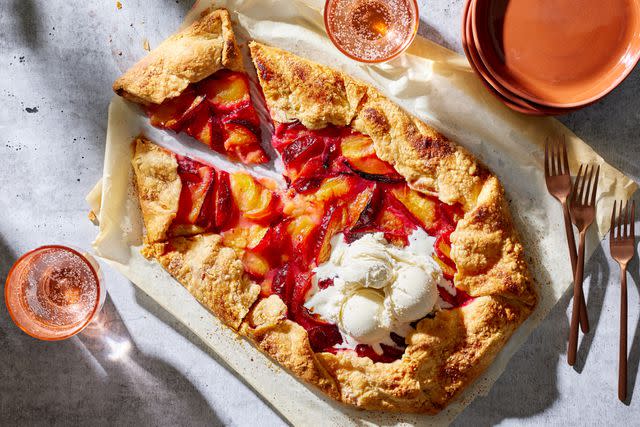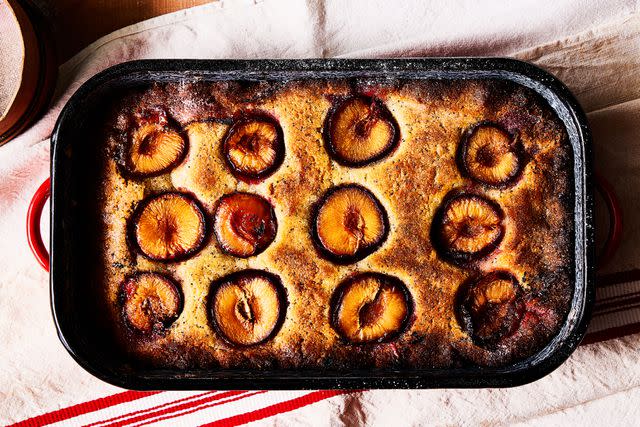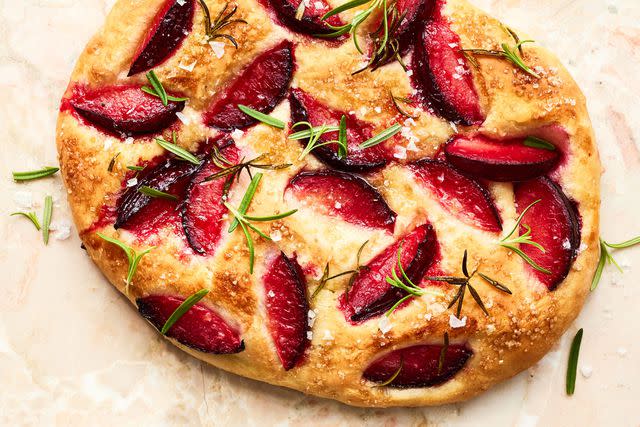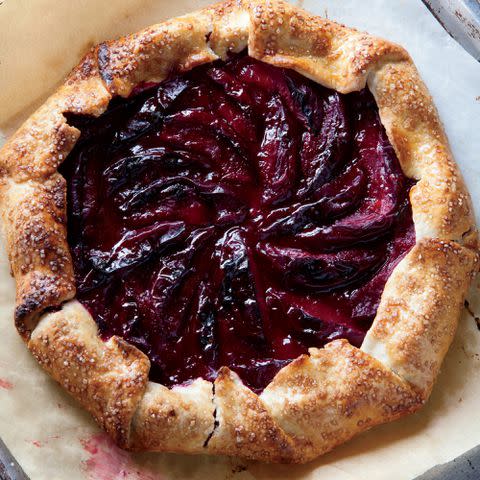10 Sweet and Tangy Plum Desserts, From Galettes to Upside-Down Cakes
Make the most of the summer fruit with these gorgeous desserts. You don’t even need to peel them!

Carson Downing / Food Styling by Annie Probst / Prop Styling by Addelyn Evans
Plums are delicious — magical even — when baked. The sweetness of the flesh and the tanginess of the skin mingle for a sweet-tart balance that pulls your fork back for another bite of cobbler or crisp. Best yet, you can play with dozens and dozens of different varieties. Here’s everything you need to know when transforming plums into buttery pies, beautiful cakes, and more.
Types of plums
Although there are hundreds of varieties of plums that are native to countries around the world, you’ll find two “families” of plums at most stores and farmers markets in the U.S. The round red plums at the grocery store are typically “Japanese” varieties (Prunus salicina and relatives, which, despite their name, originated in mainland Asia). These are most often clingstone plums, which means the pit is attached to the flesh.
European varieties (Prunus domestica) are often purple (though they can sport other colors) and oblong with freestone pits, meaning they’re not attached to the flesh of the fruit. Both varieties taste scrumptious in baked goods.
Related: 22 Stone Fruit Recipes That Are Pure Summer
There’s plenty of variety within these two families, and they both come in a broad spectrum of colors, from green to golden to ruby to midnight blue. For example, Abbi Schilling, owner of Mick Klug Farms in Michigan, grows a fantastic array of plums when they’re in season in the Midwest, from mid-July through late September. Mick Klug Farms sell dozens of varieties, from stalwarts like Santa Rosa and Stanley to Bubble Gum, Shiro, and Castleton. They even grow tiny, concentrated Damson plums — which make fantastic jam (and gin).
How to bake with plums
Plums are easy to bake with because you don’t need to peel them. In fact, you shouldn’t peel them — the skin has a tangy flavor that tastes fantastic when baked.
Taste your plums before baking with them; some plums are very sweet, while others range from mild to tangy. Adjust sugar levels accordingly. Some plums, like a super-sweet Mirabelle or Bubble Gum, don’t need any additional sugar. Oblong purple European-style plums like Stanley are typically less juicy, so they work well in any situation — I prefer these varieties in cakes because they’re less prone to a soggy final product, and give you jammy pockets of plummy goodness. Round Japanese varieties vary, but require a bit more thickener to counteract the juiciness when baked.
"Plums are easy to bake with because you don’t need to peel them. In fact, you shouldn’t peel them — the skin has a tangy flavor that tastes fantastic when baked."
Bakers can employ plums for many jobs, from plum upside-down cakes to plum galettes. I giggle with glee when I see Abbi’s first Early Gold plums of the year — I cook them up with a bit of sugar and cornstarch for a mind-blowingly good filling for hand pies. When I tell people that they’re filled with plums, they frown. But then they take a bite, and their eyes light up. Mission accomplished. I’ll make the same pie filling with bright yellow Shiro plums for an elegant, lattice-topped crostata. And don’t limit your deep-dish pies to apple and cherry — a plum pie is a showstopper.
Firm, somewhat dry European varieties like Italian prune plums and Stanley plums aren’t great for eating fresh, but they shine when baked. Germans call them Zwetchgen, and the classic Zwetchgenkuchen cake appears across the country every fall, often with a yeasted dough base and jammy plums on top — with or without streusel. People highly underestimate the glory of a good plum jam.
Related: The Difference Between Jam, Jelly, and Other Fruit Preserves
Central Europeans also love a plum spread (spiced or not), similar to a plum butter or jam, called Powidl (in Austria) or Pflaumenmus (in Germany). They’ll use this concoction to fill beloved Buchteln buns or warm, steamed Germkn?del.
Plums pair well with all kinds of flavors. Ginger is my go-to, but dark-colored plums can even handle potent spices like cinnamon, cardamom, clove, and allspice.
Also, don’t limit your use of plums to sweets. These summer stone fruits make fantastic sauces and glazes, can be baked on meat or hearty fish, or are wonderful when sliced into a savory summer salad.
How to pit plums
For freestone plums such as oblong European varieties: Using a paring knife, slice around the perimeter of the plum, following the natural indent, then simply twist the two halves apart before slicing.
For clingstone varieties, which include most Japanese varieties: Using a paring knife, slice the plum from top to tail, positioning the knife about one-eighth inch from the plum’s prime meridian so you miss the pit. Cut the two cheeks off, then slice the two remaining pieces.
Once you’ve sliced your plums, make them the star of the 10 desserts below.
Almond-and-Plum Snack Cake

Made with thick and sweet almond paste, this moist cake is topped with ripe red plums and a scattering of toasted almonds.
Plum Galette

Carson Downing / Food Styling by Annie Probst / Prop Styling by Addelyn Evans
This gorgeous tart from legendary chef Jacques Pépin pairs in-season plums with a buttery, flaky crust that comes together easily in a food processor. Double down on plums with plum preserves for the filling, or use any fruit preserve of your choice.
Szilvás Pita (Plum-and-Poppy Seed Cake)

Aubrie Pick
This Hungarian country-style cake from cookbook author Sarah Copeland is a traditional morning or afternoon snack. Use firm-ripe plums so they hold their shape during baking.
Sweet Plum Focaccia

This airy focaccia from cookbook author Kate Leahy is the perfect showcase for ripe plums, which caramelize in the oven as it bakes. Rosemary and flaky sea salt add a savory edge.
Summer Plum Crostata

For this rustic dessert, chef Kelly Liken uses Colorado plums, which she loves for their “beautiful tartness.” However, you can use any firm-but-ripe plums.
Plum Upside-Down Cake

Put plums on display with a lovely upside-down cake from chef Joanne Chang. Layered over homemade caramel, the fruits caramelize as the cake bakes for an irresistible topping.
Plum Puff Dumplings

For this elegant take on fruit danishes, former F&W senior test kitchen editor Grace Parisi tosses plum wedges with sugar and cardamom, then pinches them into puff pastry pockets and bakes them to buttery perfection.
Plum Cobbler

This easy cobbler is a great way to use an abundance of summer plums ?— the filling calls for four pounds!
Nectarine-and-Plum Crisp with Oatmeal Streusel

Double the stone fruit, double the fun. Here, juicy nectarines and plums are topped with a crumbly and wholesome oatmeal streusel.
Apricots and Plums Poached in Rosé Wine

Inspired by the harvest in Spain’s Navarra winemaking region, chef Alex Raij poaches tangy plums and apricots in a rosé made from Garnacha grapes.
For more Food & Wine news, make sure to sign up for our newsletter!
Read the original article on Food & Wine.